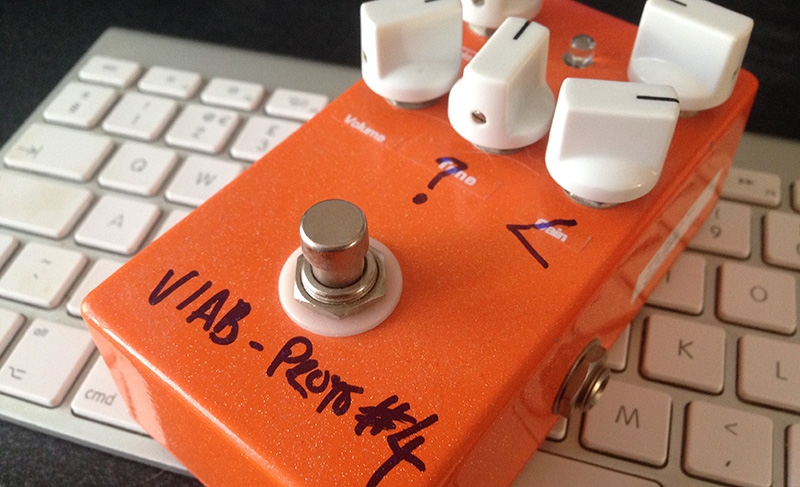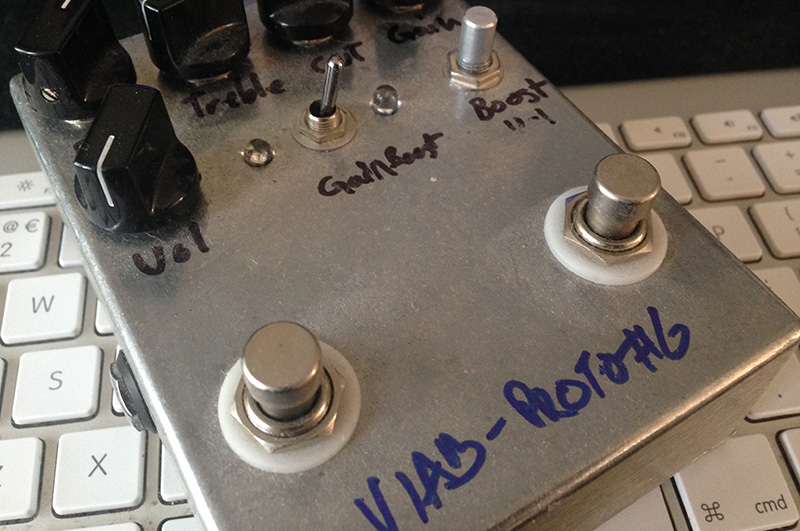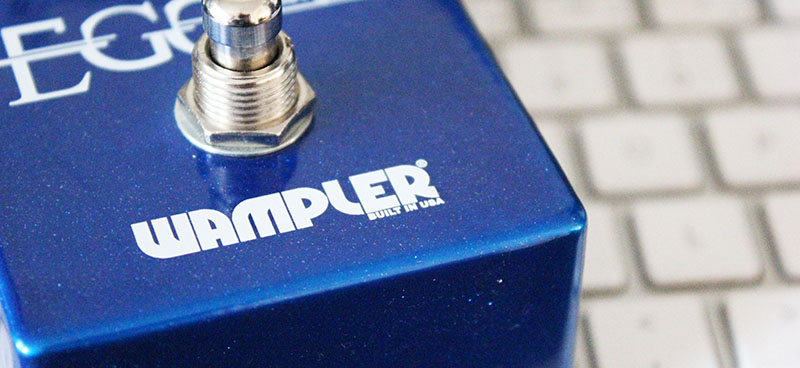
As you might expect, one of the things we hear a lot from some people is “How can you charge $200 for a pedal that I can buy the parts for, for less than $50, and make it myself?”
Right, let’s get comfy and pick this apart piece by piece. I’ll do my best to remain objective and not end up in a socio political rant about ethics, but you know, if you poke the bear sometimes you get bitten! But, I’ll try to keep my muzzle on and remain professional! lololz.
Let’s take the Thirty Something. A pedal that we sell for $239 USD. The first thing you have to remember is that Brian didn’t wake up one day and have it all mapped inside his head, he didn’t just do a “Let It Be” and have it ready from a dream. I kid you not that Brian took almost 3 years to design that circuit, it went through more prototypes than any other Wampler I know of (and I’m pretty certain I’m up to speed on this stuff), it was tweaked, changed, restarted, thrown in the bin so many times I actually stopped asking about it. When it was finally ready I remember Brian saying “I’m still not 100% happy with it, but I just can’t see how I can make it any closer”. That being said, when it arrived in Wildling territory and I plugged it in, I was staggered how it reacted and how it felt. I still think it remains the benchmark in AIAB pedals, it does the job perfectly. And I was brought up playing Edge, Queen, The Beatles and Hank Marvin songs… so, I’m kinda fussy with VOX tones.

Thinking about that, and thinking about how Brian is considered in his field, can you begin to imagine how much investment that is? To import a design engineer and have them work at something on and off for 3 years would be hundreds of thousands of dollars, I can’t comprehend how much it would be, but just think about that minute, that is a lot of R&D work, and you know, with a large family to support and employees to pay, that kind of work doesn’t pass unnoticed by the company accountant. R&D aside, then you have to imagine that once again, the designs of everything else doesn’t appear out of thin air, the pedal logo needs designing, the box art, the manual, the marketing, the demo videos, the promo shots… it’s actually quite ridiculous when you think about it, costs a bloody fortune.
Here is a picture I took for the marketing for the release of the Thirty Something. I am very lucky that I live near Manson’s Guitar Shop and have a great relationship with them (they stock us). I go in, take over a corner of the shop, use their stock guitars as backing and then spend a long time photoshopping the picture to make it look like this. It all adds up!

Now, we get to parts. Brian is RIDICOUSLY fussy about parts. He will only use parts that fulfil his requirements, and there was a stage at one point in time when we were ditching 2/3rds of a certain part because they didn’t come up to scratch – mere mortals like me can’t hear the difference, but let’s face it, I’m not Brian Wampler, his ears are better than mine and I expect most of yours as well, so you have to budget that as well.
So, let’s get back to the meat of this. You will find websites all over the internet that ‘kindly’ reverse every pedal ever made and post the schematic for all to plagiarise, errmmm, I mean “study”. So, once we’ve spent ages designing and marketing a pedal and released it, someone can then probably go to their favorite online parts store and order the parts, an enclosure and get pretty close to how the original is. I say pretty close, because I can guarantee that the components won’t be to the spec Brian demands, it won’t be laid out as well and let’s face it, I expect the basic soldering won’t be that good. We stand by our 5 year guarantee, I bet the places the parts are bought from don’t!
Let’s now look at this from another angle. And throughout this, I’m not going to mention any prices, because people will jump on it, but just think about where we are and what we are doing in this, and where you can buy it. We are not a retailer. We do not sell to the general public (we do offer direct sales through our site, but they account for next to nothing in term of units moved compared to our international sales team). We are a manufacturer. We manufacture a product, and then sell it to people who sell it through their own stores. Sometimes we sell it to a distributor who then sells it to a dealer… taking local and international taxes, shipping, the price goes up. Then I must mention the 5 year guarantee again… So, if you want to try a product in store, have that store stay open to offer you a service, you see where we, and everyone else, is coming from. Having said that, some pedals are overpriced for what they are. I’m not going to mention anything or anyone specifically here, but there are pedals out there that are basic reworked clones, with minimal R&D, with a crappy box, labelled with one of those crappy Embosser Label Maker gun things that are for sale direct from manufacturers that are silly prices, but that’s their conscience, not ours!
Made in USA. What does that mean? You may have noticed we’ve shifted from Made in USA to Built in USA. Why I hear you ask? (and to be fair, it’s another question we get asked a lot at the moment.) Well, to be able to say “Made in USA” with complete honesty means that every component is made in the USA, and as far as I know (and I like to think I’m up to speed) most parts are impossible to source, let alone in the numbers we need them, from the USA. So, we source parts – as does EVERYONE else, from around the world – we just wear that information on our sleeves. The same burden of consistency and quality is applied, and we use only the very best. I would say that if a pedal is sourced from USA components (if it was actually possible) you’d be looking at a pedal that is at least 3 or 4 times the price, and you can imagine how many of them we’d sell! (worth noting that technically, it’s illegal for any pedal company to say “Made in the USA” due to the reasons above. We just found this out recently and changed the wording to be in accordance with US law).

When you think about a $199.97 pedal (also: inflation. www.usinflationcalculator.com a pedal that costs $199 today would have sold for $107 in 1990. Ever since 2007, we’ve had a main price of about $199 unless it’s a deluxe pedal. Accounting for inflation, that pedal SHOULD cost $235.10 in 2017, yet we’ve never raised that 199 price), remove the dealer margin, shipping, taxes and everything else (I’m not going to even go to how we manage to sell our stuff for virtually the same price all over the world, give or take $30 or so dollars) then start to think about production costs, there isn’t a lot of room to think about R&D and then the guarantee period. Now do the same with a pedal that is $149, $129 or $99 – think about how much it costs to build and how many compromises have to be made in those price reductions – kinda makes you wonder doesn’t it. Strip it back, work it out, and then you think about the Built in USA (as our stuff is) you’ll see that not only are we bringing you a quality USA product, but paying quality USA salary for the guys who design, build, test, market, sell and repair (which isn’t very often thankfully) our stuff… Then look at the guys who will sell you a clone of a pedal that is still in production for $50. Do you think that will give you the same pedal? Do you think that will encourage companies like us to continue to make quality products that will inspire you to sound the best you can do?



I am a believer.
I have 10 pedals right now. Only one of them is not a clone. It was originally developed in 1978 and going strong. It is clearly of much better quality. I feel it either sounds better or maybe I just like the sound in particular. Built way better, ergonomic, and more pleasing to the eye.
In hindsight I’d gladly trade all of my other pedals for a Wampler Ego right now.
I guess buying some cheap pedals was apart of my beginner guitar experience.
I think I might cash the brunt of them in towards the Ego.
Now, to decide if it will be the big one or the mini…
I have played, borrowed, tried, and used Wampler pedals many a time. Although I currently don’t own one due to budget constraints, I can attest that if Mr. Wampler makes a claim about how a particular pedal sounds, it is VERY accurate. His pedals are also built like a tank in that they would probably take a hit from an rpg and keep working. I recently had a pedal that markets themselves as boutique die. I had it for four months on my STUDIO board so it wasn’t getting tossed around, having to deal with random fluids from drunk patrons being spilled on it, etc. When I contacted them about it, I got no response. I contacted them multiple times and STILL got no response. Finally, due to being fed up, I opened the pedal thinking that the intermittent opens I was getting (loud pops like when you plug and unplug a guitar from a hot amp) were from a broken solder joint only to find that it wasn’t a broken solder joint, it was the wiper of the volume control being loose inside the the pot. If I had spent the normal $120 instead of the $50 clearance price, I would have been livid. When the pedal arrived I was also disappointed to see a made in China label (actually designed in the U.S.A and manufactured in China).
This has NEVER been the case with the Wampler brand. As a prospective buyer, I have contacted Wampler pedals on more than one occasion and have ALWAYS gotten a response from Brian himself (and yes I will eventually be taking your advice, Brian and getting the Dracarys). This speaks volumes when you consider how busy he is. So if you put that together with the absolute wonderful tones, accurate marketing, and quality, it’s no wonder you pay more. You are paying for some of what I call, intangibles. After having played the Pinnacle, Sovereign, and Dracarys I can tell you they really, at least in my opinion and through my personal rig, have no equal.
On a side note, I keep waiting for the cheap knockoff of the Dracarys to come out with some absurd name like Drakkarish (anyone remember the 80s?)that will sound like a vague similarity and last about two weeks.
The people who complain about the cost of a $199 pedal, designed and assembled in a first world country, have not a clue about the costs of manufacturing, distribution and retail sales. If it isn’t sold directly, that means the manufacturer has to turn a profit selling at 60% of the suggested retail price, because the retailer wants to make money too. I figure the multiplier for manufacturer costs is 3.33. Every dollar of cost for the manufacturer ends up costing the retail customer $3.33. What’s the customer getting for the additional $2.33? Not having to design the circuit, track down all the parts, and assemble them, plus marketing costs.
Most folks don’t know that the cost for the mechanical parts for a pedal (enclosure, jacks, switches, potentiometers) often exceed the cost of the circuit.
While I completely agree with what you’re saying, this was not a tasteful response. This seems like a response of someone who’s feelings are hurt. The amount of times you go out of your way to insult people is unnecessary. Stick to the facts dude. You catch more flies with honey, or in this case, would change more people’s minds without insults.